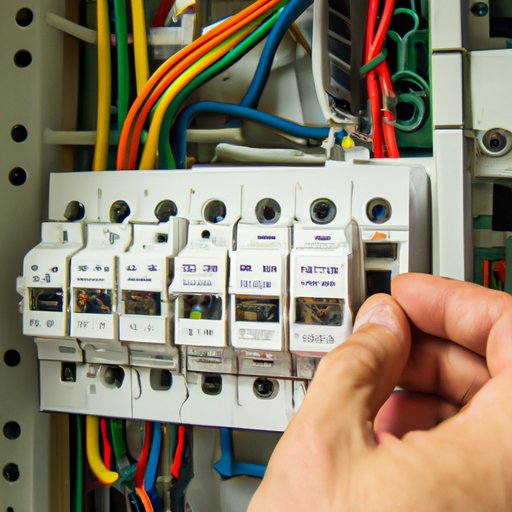Introduction
Have you ever experienced a breaker trip in your home or office? This can be a frustrating problem, as it can cause disruption to your day-to-day activities. But what exactly is a breaker trip, and why do they happen?
A circuit breaker is a device that acts as a safety switch for electrical circuits. It is designed to detect electrical overloads and shut off the power supply to prevent fires or other damage from occurring. In the event of an overload, the breaker trips and cuts off the power supply.
In this article, we’ll explore why your breakers might be tripping and provide some tips on how to handle the problem. We’ll also discuss when it’s time to call an electrician for help.

Identifying the Causes of Tripping Breakers
The first step in understanding why your breakers are tripping is to identify the cause of the problem. To do this, you need to check for overloaded circuits, faulty wiring, and other potential issues.
Checking for Overloads
One of the most common reasons for breakers tripping is an overloaded circuit. When too many appliances and devices are plugged into one circuit, the circuit becomes overloaded and the breaker trips to protect the electrical system. To determine if this is the issue, unplug any unnecessary appliances or devices from the circuit and see if the breaker stays on.
Examining Wiring and Connections
Another potential cause of breaker trips is faulty wiring or connections. Loose wires or faulty connections can cause an overload and lead to a breaker trip. If this is the case, you should contact an electrician to inspect the wiring and make any necessary repairs.
Common Reasons for Breaker Tripping Issues
Once you’ve identified the cause of the breaker trip, there are several common reasons why breakers may be tripping. These include age of the circuit breaker, faulty appliances or devices, and improperly sized circuit breakers.
Age of the Circuit Breaker
Older circuit breakers can become worn out over time and may not be able to handle the same load as newer models. If your home has an older circuit breaker, it may be time to replace it with a newer model.
Faulty Appliances or Devices
If you have an appliance or device that is malfunctioning, it could be drawing too much power and causing the breaker to trip. Unplug any faulty devices and see if the breaker stays on.
Improperly Sized Circuit Breakers
If your circuit breaker is not properly sized for the amount of power being drawn, it could be tripping due to an overload. A professional electrician can help you determine if your circuit breaker is properly sized.

How to Reset a Tripped Breaker
Once you’ve identified the cause of the breaker trip, you can reset the breaker. This process is simple and can be done in just a few steps:
- Locate the circuit breaker box.
- Find the tripped breaker. It should be labeled or marked in some way.
- Switch the breaker to the “off” position.
- Wait a few seconds before switching it back to the “on” position.
Once you’ve reset the breaker, check to make sure that the power is back on and that the breaker isn’t tripping again. If it is, you may need to investigate further to identify the cause of the problem.
Tips on Preventing Breaker Trips
To avoid having to reset a tripped breaker, there are some steps you can take to reduce the risk of an overload. These include using surge protectors, avoiding overloading circuits, and checking electrical wiring.
Use Surge Protectors
Surge protectors are devices that protect electrical equipment from voltage spikes. They can help reduce the risk of an overload by absorbing excess current and preventing it from reaching the circuit breaker. Make sure to use surge protectors for all sensitive electronics such as computers, televisions, and appliances.
Avoid Overloading Circuits
Overloading circuits is one of the most common causes of breaker trips. To avoid this, make sure to spread out your appliances and devices over multiple circuits and don’t plug too many items into one outlet.
Check Electrical Wiring
Poorly installed electrical wiring can also lead to breaker trips. Make sure to have any wiring checked by a professional electrician to ensure it is up to code and free of any defects.

Advice on When to Call an Electrician to Help with Breaker Problems
In some cases, it may be best to call an electrician to help with breaker problems. This is especially true if you’re dealing with complex wiring issues, frequent breaker trips, or unsafe conditions.
Complex Wiring Issues
If you’re dealing with complex wiring issues, such as multiple circuits connected to one breaker, it’s best to call an electrician for help. An electrician can inspect the wiring and make sure it is up to code and functioning properly.
Frequent Breaker Tripping
If your breakers are tripping frequently, it could be a sign of a more serious problem. In this case, it’s best to call an electrician to inspect the wiring and identify any underlying issues.
Unsafe Conditions
If you suspect that your circuit breaker is not working properly, or if you notice any signs of an electrical fire, it’s important to call an electrician right away. An electrician can inspect the wiring and ensure that your home is safe.
Conclusion
Troubleshooting breaker trips can be a difficult task, but knowing the causes and identifying the solutions can help you resolve the issue quickly and safely. By following the tips outlined in this article, you can help prevent future breaker trips and keep your home or office running smoothly.
(Note: Is this article not meeting your expectations? Do you have knowledge or insights to share? Unlock new opportunities and expand your reach by joining our authors team. Click Registration to join us and share your expertise with our readers.)
